The Orange O Bones promise to deliver better music fidelity than other bone conduction headphones but doesn’t quite live up to that promise. While it offers a comfortable design and okay battery life, there are certainly better sounding options to consider.
Pros
- Light design
- Well positioned physical controls
- Quick charge feature
Cons
- Sound quality not very memorable
- Tickle at loud volumes
- Charging port seal feels a bit flimsy
-
Sound16mm drivers for audio -
BatteryA quite 8 hours of battery life
Introduction
The O Bones from British audio outfit Orange Amps, is part of a new raft of bone conduction headphones seeking to prove there’s a world outside of Shokz, who dominate this space.
Coming in at around the same price as Shokz cheapest headphones, the OpenMove, the O Bones promise to deliver clear, high sound quality, voice assistant support and up to eight hours of battery.
As mentioned, there’s a lot of cheap bone conduction headphones out there now, so do the O Bones from Orange Amps stand out from the conduction crowd?
Availability
- UKRRP: £79
- USARRP: $92.20
- EuropeRRP: €93.85
- CanadaRRP: CA$122.53
- AustraliaRRP: AU$138.61
The Orange O Bones are available to buy directly from the Orange Amp website for £79 / $94.20 / $AUD138.61.
Design
- Water resistant design
- Physical volume controls
The O Bones settle on a pretty typical look for bone conduction headphones, opting for a neckband design that’s made from plastic with a rubber coating to give it a more durable feel. It’s a bendable frame that does seem to handle a fair amount of flex, which is ideal if you’re going to be throwing it into a bag.
It comes with its own carry pouch and you do get a set of earplugs when you want to better isolate sound, while there’s a USB-C charging cable also supplied to power them up.
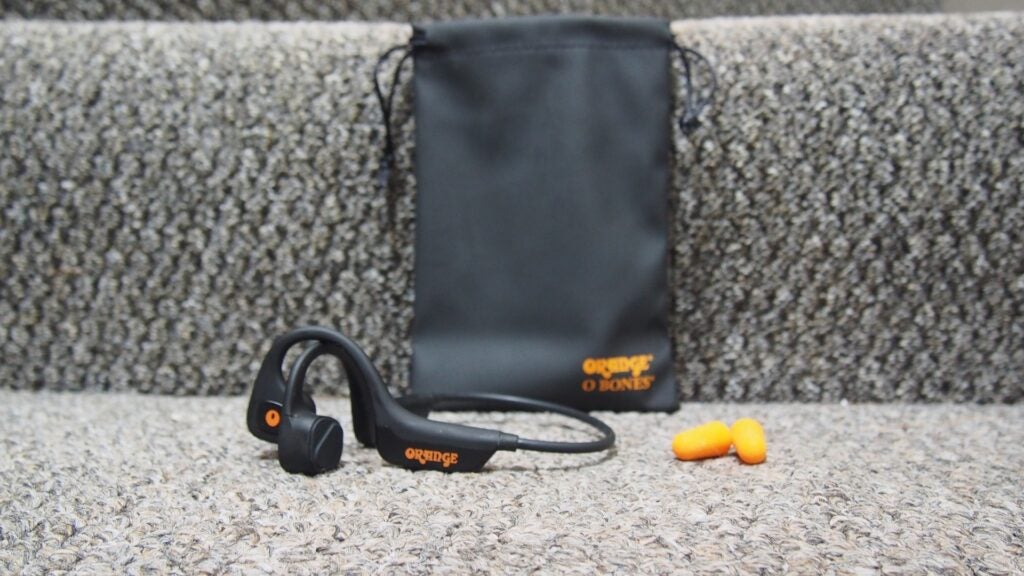
There are a set of microphones that sit behind the ear to let you use them for calls and dealing with your smartphone’s smart assistant. On one side of the headphones you’ll find a set of physical buttons tucked away on the right side of the headphone frame, which let you adjust volume. There’s an additional bigger physical button further ahead that’s used to turn the headphones on and off and play/pause audio. It’s all pretty straightforward stuff and easy to use controls when you’re stationary or on the move, which is good to have.
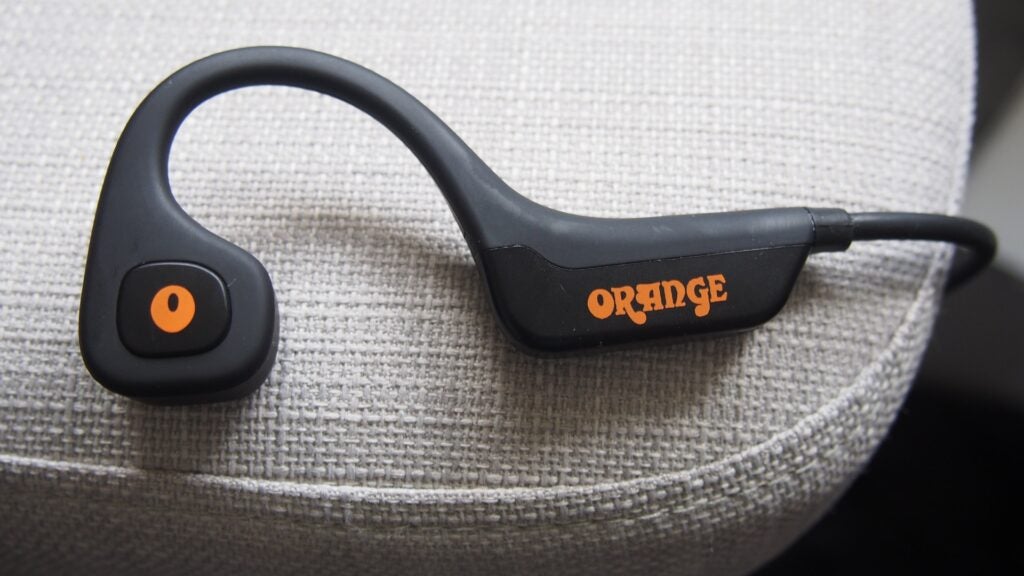
Orange Amps says the O Bones are also water resistant, carrying an IPX4 rating, which means they’re resistant to splashes of water from all directions. I’d say the headphones should hold up well against sweat and some rain. There’s not been a lot of rain to test them out in, but in the sweaty confines of a gym during tough running and rowing workouts, the O Bones have survived without issues.
Features
- Microphone for calls and smart assistant control
- Up to seven hours battery life
On the connectivity front, it’s been solid overall. You’ve got Bluetooth 5.0 keeping that wireless connection with your phone and I’ve used it with an Android phone and a Mac and haven’t suffered any dropouts in my testing time. There’s no multi-point support, so if you’re hoping to use it to quickly switch between devices, you’re out of luck.
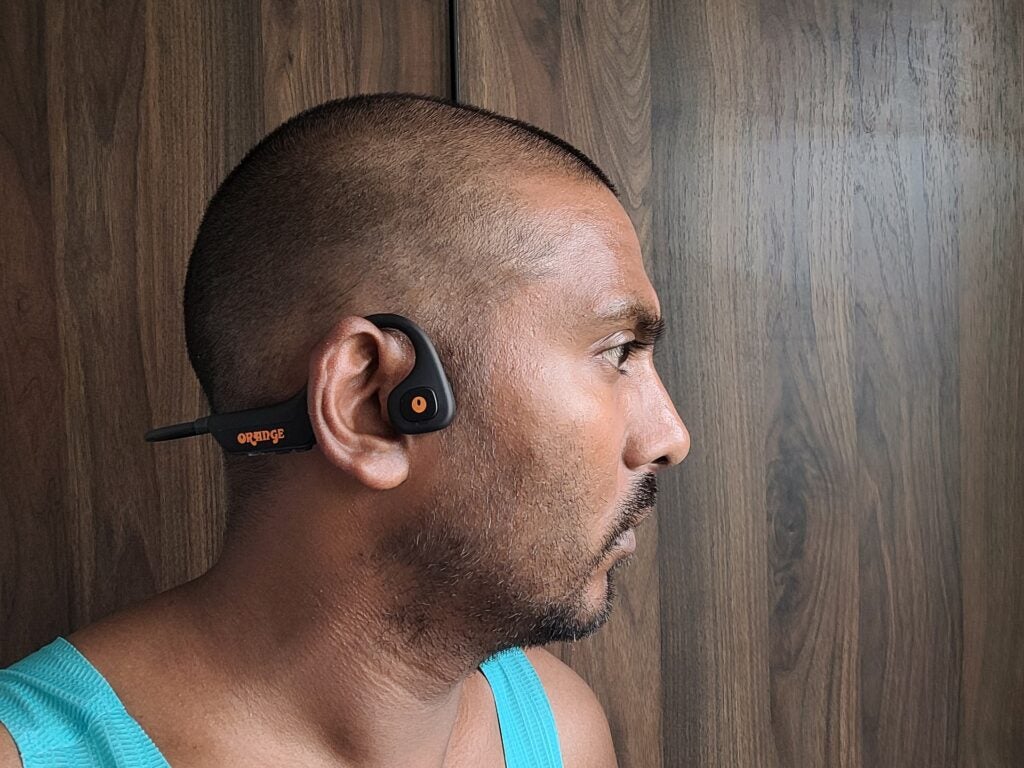
Battery life is quoted as being seven hours, but that clearly depends on how much you crank that volume up. I found from an hour’s listening outdoors at near top volume, which was necessary to get the best performance, the battery dropped 20% (100% to 80%). That would actually work out to about five hours and is short of the quoted seven hours.
When you need to charge, there’s quite a soft rubber latch on the underside of the headphones next to the volume controls, which you can lift away to plug in the supplied USB-C charging cable. Charging can take anywhere from 1-2 hours when they’ve gone flat, with a quick charge feature getting 1.5 hours of listening time from a 5-minute charge, which is useful to have.
Sound Quality
- 16mm driver
- Muddy sound
- Doesn’t achieve good balance between audio and environmental noise
Like all bone conduction headphones, you’re going to have to accept some compromises in sound quality. That’s ultimately the nature of the open–ear headphones and bone conduction technology. The good news is that in general, things are getting better with bone conduction but in the case of the O Bones, it’s not raising the bar in terms of performance.
There’s 16mm drivers to punch out audio in proximity of your ears using transducers to fire those vibrations up your cheek to generate that sound. A 80hz-5000hz frequency response, is an indication of what to expect in that bass, treble and mids departments.
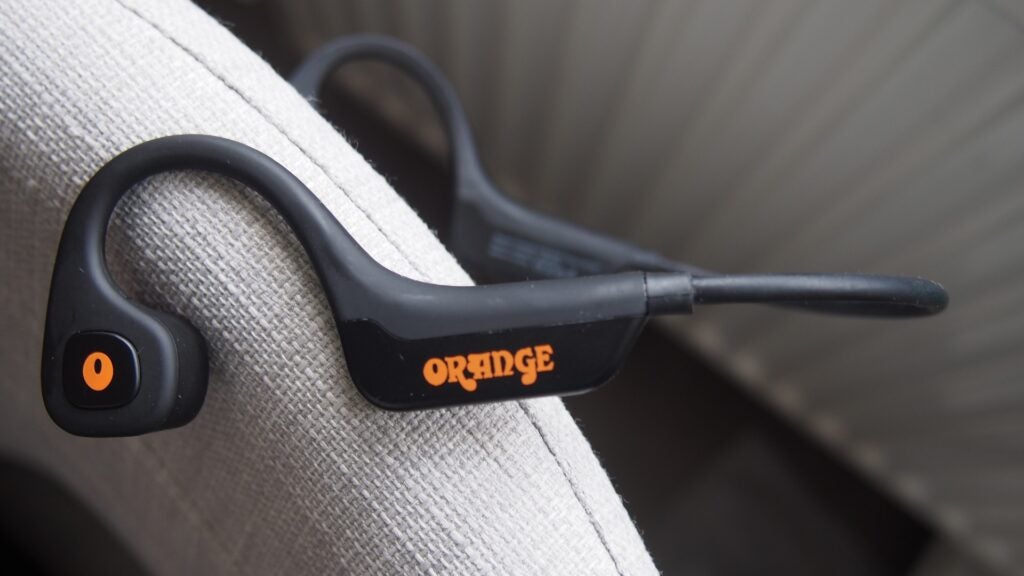
What bone conduction headphones generally prioritise is providing clarity and detail with a bump in bass a bit of a bonus. Unfortunately, the O Bones don’t really excel on any of those fronts.
The overall sound profile is muddy and while they offer good top volume, those vibrations are more noticeable on bass-heavy music, which is characteristic you don’t like or expect to see on bone conduction headphones these days.
Step away from more powerful and bassy audio and the treble performance feels harsh while mids are far from smooth sounding. Putting in the supplied earplugs didn’t make a difference either. It’s almost like there’s good sound fighting to get out of these headphones, but it doesn’t quite achieve it. These are by no means the worst sounding bone conduction headphones I’ve used but it also doesn’t generate something very memorable or noteworthy either.
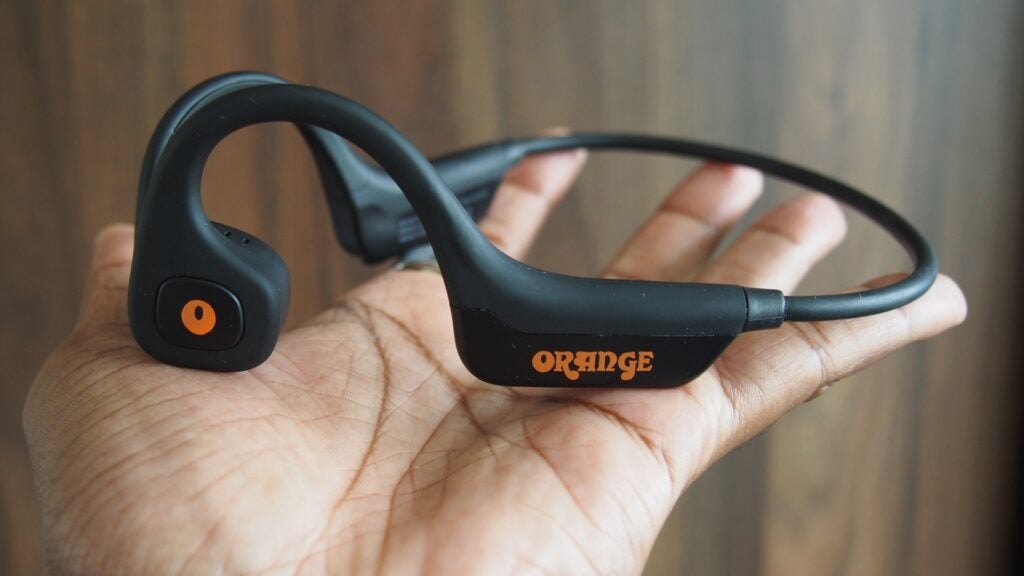
The true test though is how well that sound performs when you need to be aware of your surroundings. I’d say the mix of audio and environmental sound feels more weighted towards the latter. I found in even moderately noisy environments like running outside in the wind or next to traffic, in a gym battling music from speakers or on the train or bus, that exterior sound really wins the battle against hearing your own audio. It’s supposed to be balanced, but that’s just not the case here.
It doesn’t get better if you’re switching to using it for calls or interacting with your phone’s smart assistant. Outside, you’re battling for clear call quality and the wind does quite easily cut through. It’s generally fine indoors, but if you’re in louder environments, these struggle to give the kind of rewarding call quality you’d hope for.
Latest deals
Should you buy it?
You want a light and affordable pair of bone conduction headphones For less than £100/$100, you’ll get a comfortable set of bone conduction headphones with okay sound and battery life.
You want great sounding bone conduction headphones While the O Bones promises better sound than the competition, it sadly doesn’t deliver on that front.
Final Thoughts
There is a world outside of Shokz bone conduction headphones and you can buy alternatives that offer a good all-round package of sound, design and battery performance. The Orange O Bones delivers in some of those areas, but crucially not in the one that should matter – the sound one. If you’re looking for bone conduction headphones with good sound, fit and battery, look at brands like Viddon or Naenka or spend more on one of Shokz’ pricier headphones instead.
How we test
We test every headphones we review thoroughly over an extended period of time. We use industry-standard tests to compare features properly. We’ll always tell you what we find. We never, ever, accept money to review a product.
Find out more about how we test in our ethics policy.
Tested with real world use
FAQs
Bluetooth multi-point is supported by this model, so it can only be used with one device at a time.
Sustainability
Trusted Reviews’ holds the fact that global warming is not a myth as a core value and will continuously endeavour to help protect our planet from harm in its business practices.
As part of this mission, whenever we review a product we send the company a series of questions to help us gauge and make transparent the impact the device has on the environment.
We currently haven’t received answers to the questions on this product, but will update this page the moment we do. You can see a detailed breakdown of the questions we ask and why in our sustainability info page.
Jargon buster
Bone conduction
Transmits sound waves to the ear by vibrating bones in the skull, a technique used by a number of fitness-based headphones
USB-C
The modern USB connector you’ll find on most Android phones, new laptops, cameras and games consoles. It’s reversible and used for charging along with data-transfer.
The Orange O Bones promise to deliver better music fidelity than other bone conduction headphones but doesn’t quite live up to that promise. While it offers a comfortable design and okay battery life, there are certainly better sounding options to consider.
Pros
- Light design
- Well positioned physical controls
- Quick charge feature
Cons
- Sound quality not very memorable
- Tickle at loud volumes
- Charging port seal feels a bit flimsy
-
Sound16mm drivers for audio -
BatteryA quite 8 hours of battery life
Introduction
The O Bones from British audio outfit Orange Amps, is part of a new raft of bone conduction headphones seeking to prove there’s a world outside of Shokz, who dominate this space.
Coming in at around the same price as Shokz cheapest headphones, the OpenMove, the O Bones promise to deliver clear, high sound quality, voice assistant support and up to eight hours of battery.
As mentioned, there’s a lot of cheap bone conduction headphones out there now, so do the O Bones from Orange Amps stand out from the conduction crowd?
Availability
- UKRRP: £79
- USARRP: $92.20
- EuropeRRP: €93.85
- CanadaRRP: CA$122.53
- AustraliaRRP: AU$138.61
The Orange O Bones are available to buy directly from the Orange Amp website for £79 / $94.20 / $AUD138.61.
Design
- Water resistant design
- Physical volume controls
The O Bones settle on a pretty typical look for bone conduction headphones, opting for a neckband design that’s made from plastic with a rubber coating to give it a more durable feel. It’s a bendable frame that does seem to handle a fair amount of flex, which is ideal if you’re going to be throwing it into a bag.
It comes with its own carry pouch and you do get a set of earplugs when you want to better isolate sound, while there’s a USB-C charging cable also supplied to power them up.

There are a set of microphones that sit behind the ear to let you use them for calls and dealing with your smartphone’s smart assistant. On one side of the headphones you’ll find a set of physical buttons tucked away on the right side of the headphone frame, which let you adjust volume. There’s an additional bigger physical button further ahead that’s used to turn the headphones on and off and play/pause audio. It’s all pretty straightforward stuff and easy to use controls when you’re stationary or on the move, which is good to have.

Orange Amps says the O Bones are also water resistant, carrying an IPX4 rating, which means they’re resistant to splashes of water from all directions. I’d say the headphones should hold up well against sweat and some rain. There’s not been a lot of rain to test them out in, but in the sweaty confines of a gym during tough running and rowing workouts, the O Bones have survived without issues.
Features
- Microphone for calls and smart assistant control
- Up to seven hours battery life
On the connectivity front, it’s been solid overall. You’ve got Bluetooth 5.0 keeping that wireless connection with your phone and I’ve used it with an Android phone and a Mac and haven’t suffered any dropouts in my testing time. There’s no multi-point support, so if you’re hoping to use it to quickly switch between devices, you’re out of luck.

Battery life is quoted as being seven hours, but that clearly depends on how much you crank that volume up. I found from an hour’s listening outdoors at near top volume, which was necessary to get the best performance, the battery dropped 20% (100% to 80%). That would actually work out to about five hours and is short of the quoted seven hours.
When you need to charge, there’s quite a soft rubber latch on the underside of the headphones next to the volume controls, which you can lift away to plug in the supplied USB-C charging cable. Charging can take anywhere from 1-2 hours when they’ve gone flat, with a quick charge feature getting 1.5 hours of listening time from a 5-minute charge, which is useful to have.
Sound Quality
- 16mm driver
- Muddy sound
- Doesn’t achieve good balance between audio and environmental noise
Like all bone conduction headphones, you’re going to have to accept some compromises in sound quality. That’s ultimately the nature of the open–ear headphones and bone conduction technology. The good news is that in general, things are getting better with bone conduction but in the case of the O Bones, it’s not raising the bar in terms of performance.
There’s 16mm drivers to punch out audio in proximity of your ears using transducers to fire those vibrations up your cheek to generate that sound. A 80hz-5000hz frequency response, is an indication of what to expect in that bass, treble and mids departments.

What bone conduction headphones generally prioritise is providing clarity and detail with a bump in bass a bit of a bonus. Unfortunately, the O Bones don’t really excel on any of those fronts.
The overall sound profile is muddy and while they offer good top volume, those vibrations are more noticeable on bass-heavy music, which is characteristic you don’t like or expect to see on bone conduction headphones these days.
Step away from more powerful and bassy audio and the treble performance feels harsh while mids are far from smooth sounding. Putting in the supplied earplugs didn’t make a difference either. It’s almost like there’s good sound fighting to get out of these headphones, but it doesn’t quite achieve it. These are by no means the worst sounding bone conduction headphones I’ve used but it also doesn’t generate something very memorable or noteworthy either.

The true test though is how well that sound performs when you need to be aware of your surroundings. I’d say the mix of audio and environmental sound feels more weighted towards the latter. I found in even moderately noisy environments like running outside in the wind or next to traffic, in a gym battling music from speakers or on the train or bus, that exterior sound really wins the battle against hearing your own audio. It’s supposed to be balanced, but that’s just not the case here.
It doesn’t get better if you’re switching to using it for calls or interacting with your phone’s smart assistant. Outside, you’re battling for clear call quality and the wind does quite easily cut through. It’s generally fine indoors, but if you’re in louder environments, these struggle to give the kind of rewarding call quality you’d hope for.
Latest deals
Should you buy it?
You want a light and affordable pair of bone conduction headphones For less than £100/$100, you’ll get a comfortable set of bone conduction headphones with okay sound and battery life.
You want great sounding bone conduction headphones While the O Bones promises better sound than the competition, it sadly doesn’t deliver on that front.
Final Thoughts
There is a world outside of Shokz bone conduction headphones and you can buy alternatives that offer a good all-round package of sound, design and battery performance. The Orange O Bones delivers in some of those areas, but crucially not in the one that should matter – the sound one. If you’re looking for bone conduction headphones with good sound, fit and battery, look at brands like Viddon or Naenka or spend more on one of Shokz’ pricier headphones instead.
How we test
We test every headphones we review thoroughly over an extended period of time. We use industry-standard tests to compare features properly. We’ll always tell you what we find. We never, ever, accept money to review a product.
Find out more about how we test in our ethics policy.
Tested with real world use
FAQs
Bluetooth multi-point is supported by this model, so it can only be used with one device at a time.
Sustainability
Trusted Reviews’ holds the fact that global warming is not a myth as a core value and will continuously endeavour to help protect our planet from harm in its business practices.
As part of this mission, whenever we review a product we send the company a series of questions to help us gauge and make transparent the impact the device has on the environment.
We currently haven’t received answers to the questions on this product, but will update this page the moment we do. You can see a detailed breakdown of the questions we ask and why in our sustainability info page.
Jargon buster
Bone conduction
Transmits sound waves to the ear by vibrating bones in the skull, a technique used by a number of fitness-based headphones
USB-C
The modern USB connector you’ll find on most Android phones, new laptops, cameras and games consoles. It’s reversible and used for charging along with data-transfer.
























